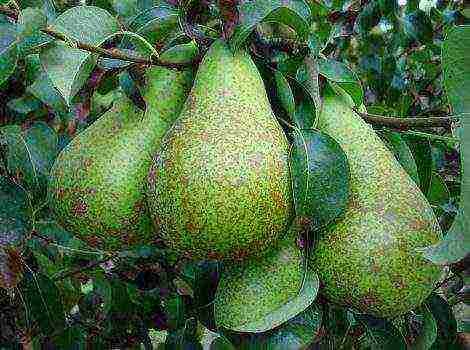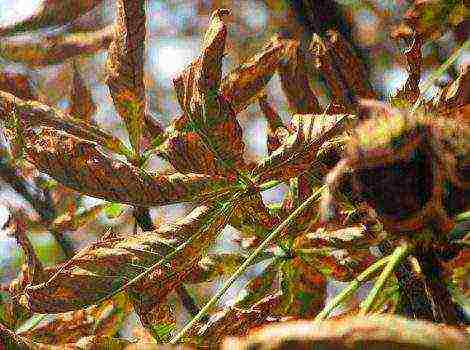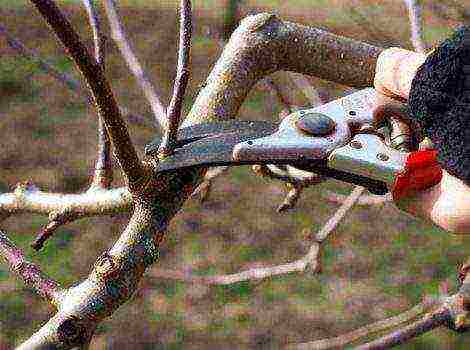Content [show]
Planting and caring for Japanese quince outdoors
If you want to decorate your site, create an original hedge and at the same time harvest healthy fruits, pay attention to the Japanese quince.
Description of an ornamental shrub, use in landscape design
Japanese quince is a low-growing ornamental shrub. She will decorate any garden in spring, when many huge (for its small stature) orange-red flowers with a diameter of up to 4 cm, which are strewn with all the branches, are blooming on it.
In summer, the plant attracts the eye with its glossy foliage with pouring fruits. In autumn, it is strewn with medium-sized yellow fruitsresembling small apples.
Shrub blooms in May and, due to the uneven opening of the buds, the bright bloom stretches for 2-3 weeks.
Spireas, forsythia and magonia will become worthy partners in garden compositions for her.
Quince has the ability to grow in breadth due to abundant root growth, and this is its quality very often used to strengthen slopes (it holds the soil).
You need to be careful with shrubs, as there are sharp thorns on some varieties.
Henomeles (Japanese quince) due to its frost resistance (withstands frosts down to -25 ° well) suitable for growing in the Moscow region... With frosts below -30 ° C, the buds may freeze, but the bush will not die.
When properly grown, the shrub grows up to 40 years old.
Japanese quince, or chaenomeles:
Outdoor planting and care
Quince is not demanding on growing conditions, but there are several conditions that must be taken into account when planting a seedling:
- the planting site should be sunny, since the shrub grows and blooms poorly in shade;
- in order to avoid freezing of bushes in severe winters, plant them in places protected from northern winds;
- the acidity of the soil should not exceed 6.5pH (slightly acidic);
- having a taproot that goes deep into the soil, the plant does not tolerate transplanting from place to place, we plant it immediately and forever;
- the distance between the bushes is 1-1.5 m, when forming a hedge 0.8-1 m.
Landing rules:
- pour about a bucket of humus with wood ash (0.5 kg) and superphosphate (0.3 kg) added into the dug planting hole (60 * 60 * 50cm), mix with a shovel with a small amount of earth;
- we place the seedling in the hole in such a way that the root collar was at the level of the soil;
- we cover the roots of the plant with earth and water it well;
- it is advisable to mulch the soil around the bushes (sawdust, chopped bark, peat).

Further care for a young seedling consists of watering, but waterlogging of the soil should not be allowed in order to avoid rotting of the roots, regular loosening of the soil around the bushes.
Since during landing all the necessary batteries were introduced, then no need to feed the plant for two years after planting.
Adult plants in the spring, after the snow melts, are fed with ammonium nitrate about 20 g per bush. In the summer, they give liquid fertilizing with organic matter (diluted mullein or bird droppings). Superphosphate is introduced in the fall.
To do this, you can use spruce branches or cover small plants with covering material (spandbond or lutrasil), put wooden or plastic boxes on top and sprinkle with fallen leaves.
Quince fruiting annually, starting from the third year after planting.
Chaenomeles cross-pollinated plant, therefore, for better pollination and increase yields, 2-3 bushes need to be planted nearby.
Features of planting chaenomeles:
Breeding methods for Japanese quince for transplant
There are several ways to breed Japanese quince.
Seeds
Due to the fact that the varietal qualities are not preserved during seed reproduction, it is used when growing rootstocks with further grafting.
Seeds collected from fruits in autumn are stored in wet sand at a temperature of about 0 ° C throughout the winter. (thus they are stratified).
Seeds are sown in planting containers in February - March, after 1.5 months they dive into separate containers and at the end of May and beginning of June the seedlings are ready for planting in open ground.
Regular watering and feeding is carried out until autumn., for the winter, seedlings that are not yet fully strengthened are insulated with fallen leaves.
The germination of such seeds is excellent., since they have undergone natural stratification, in the spring dense seedlings must be thinned out, leaving the strongest ones. By the fall, the seedlings are ready to be transplanted to a permanent place of growth.
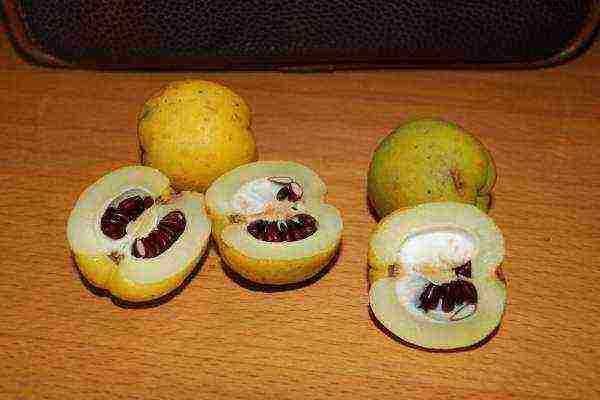
Cuttings
In early June, green cuttings are carried out... Annual cuttings with a "heel" (a piece of last year's wood) are cut. Slices are processed by "Kornevin" for better rooting and planted in the school at an angle.
To maintain humidity, cover the plantings with plastic wrap. By the fall, the seedlings are ready for transplanting to a permanent place, but it is better to do this in the spring.
You can cut ripe cuttings in the fall, dig under a bush at a depth of 20-30 cm, be sure to outline the place.
During the winter, callus forms at the ends of the cuttings, and with the onset of spring, the cuttings are planted immediately in a permanent place.
By dividing the bush
The easiest way to reproduce... Shoots with a well-developed root system are separated from the mother bush (root growth) and transplanted.
Horizontal layering
Quince often grows creeping shoots, having dug in which you can get seedlings for subsequent reproduction.

Chaenomeles pruning rules
The shrub tolerates pruning very well, but most gardeners, due to the thorniness of the plant, do not do it in vain. Quince pruning is necessary to improve growth and crown formation for decorative purposes.
There are three types of trimming:
- Sanitary - in early spring, dry, frozen and broken branches are removed.
- Formative - they begin to do it from the age of 4, when the branches begin to branch. Shoots growing inside the bush and thickening it are cut out, excess root growth is removed, leaving no more than 2-3 young shoots annually in order to avoid strong expansion of the bush in breadth. Shoots creeping on the ground are also removed, they take food on themselves and thicken the bush.
- Rejuvenating - it is produced from the age of 8 bush, when the annual growth becomes less than 10 cm.Thin and elongated shoots are removed, leaving the strongest 10-12 in the bush. When thinning, you need to remember that the most productive are shoots at the age of 3-4 years, older branches must be removed.
In order to avoid the penetration of diseases into the plant, all sections must be treated with garden varnish.
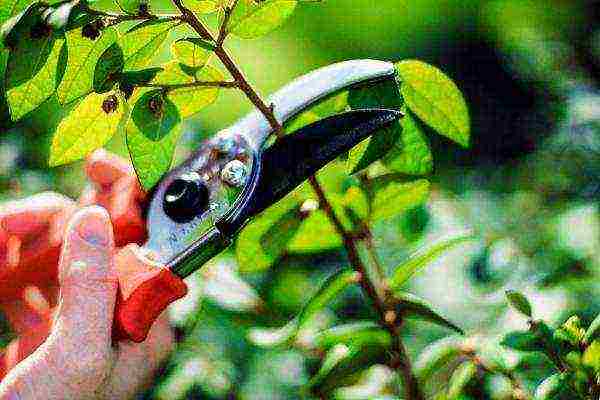
Pests and diseases
Chaenomeles is not damaged by pests and has great resistance to diseases, but in cool and rainy summers, diseases such as:
- leaf necrosis - the appearance of a gray bloom along the edge of the leaf with further spread over the entire surface of the leaf, the leaves dry out;
- cercosporia - manifests itself in the form of dark brown round spots that brighten over time;
- ramulariasis - the formation of brown spots on the leaves.
Varieties for cultivation in the Moscow region
In central Russia, low-growing varieties up to 1 m in height are grown, with arched branches and a spreading crown.
Of the domestic varieties, the most common are:
- Fragrant - bush up to 1.2 m high, winter-hardy, fruit weight 50-60 g, with a pleasant aroma;
- Nikitskaya - early ripening, medium vigor, winter hardy;
- Vitamin - winter-hardy, compact bush, with bright yellow fruits weighing up to 100 g;
- Muscat - a large-fruited variety (fruits up to 200 g), self-pollinated, winter-hardy;
- Teplovskaya - a variety of late ripening and long-term storage of fruits.
The most famous foreign varieties:
- Gaillardi - variety with large orange flowers;
- Malardi - gorgeous pink flowers with a white border;
- Papel - an interesting variety with yellow flowers and a pink border around the edge of the petal.
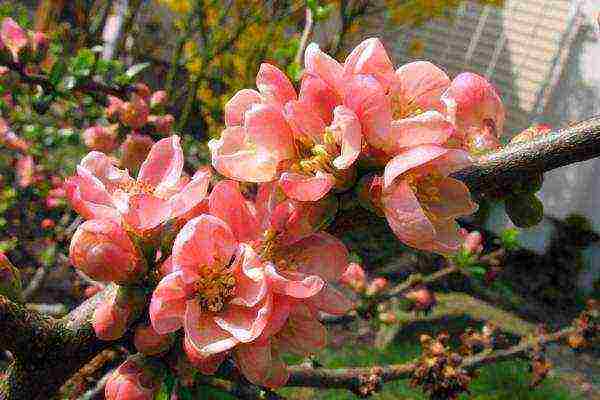
Harvesting in autumn, storing fruits
Quince fruits are small, hard and sour in taste, but very aromatic and with a high content of vitamin C. They are harvested in September - October, before the onset of frost.
They are stored at an air temperature of 1-2 ° C for 2-3 months. As a result of maturation, they become softer, the sweet aroma is enhanced.
Jams, jams are also made from the fruits of chaenomelis, and added to compotes. Due to the high iron content, chopped fruits darken quickly.
Japanese quince. Northern lemon:
Jam making
For 1 kg of quince you need: 2 kg of sugar and 1.5 cups of water. Wash the quince, dry it, remove seeds and hard white partitions, cut into small wedges.
Put slices in boiling syrup, boil over low heat for 10 minutes, removing the foam, then remove from heat and leave for 12 hours. Boil the jam again for 10 minutes, etc. until the quince slices become transparent.
We lay out the finished jam in sterilized jars, leave it until winter. In winter, aromatic jam will remind you of the beauty of flowering shrubs and the approaching warm summer.
Japanese quince is unpretentious in cultivation, it is undemanding in attention and easy to care for, but at the same time it is beautiful in flowering and useful in application.
